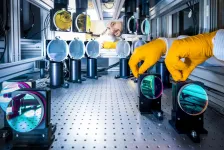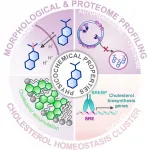(Press-News.org) Astronomers using two of the world's most powerful radio telescopes have made a detailed and sensitive survey of a large segment of our home galaxy -- the Milky Way -- detecting previously unseen tracers of massive star formation, a process that dominates galactic ecosystems. The scientists combined the capabilities of the National Science Foundation's Karl G. Jansky Very Large Array (VLA) and the 100-meter Effelsberg Telescope in Germany to produce high-quality data that will serve researchers for years to come.
Stars with more than about ten times the mass of our Sun are important components of the Galaxy and strongly affect their surroundings. However, understanding how these massive stars are formed has proved challenging for astronomers. In recent years, this problem has been tackled by studying the Milky Way at a variety of wavelengths, including radio and infrared. This new survey, called GLOSTAR (Global view of the Star formation in the Milky Way), was designed to take advantage of the vastly improved capabilities that an upgrade project completed in 2012 gave the VLA to produce previously unobtainable data.
GLOSTAR has excited astronomers with new data on the birth and death processes of massive stars, as well on the tenuous material between the stars. The GLOSTAR team of researchers has published a series of papers in the journal Astronomy & Astrophysics reporting initial results of their work, including detailed studies of several individual objects. Observations continue and more results will be published later.
The survey detected telltale tracers of the early stages of massive star formation, including compact regions of hydrogen gas ionized by the powerful radiation from young stars, and radio emission from methanol (wood alcohol) molecules that can pinpoint the location of very young stars still deeply shrouded by the clouds of gas and dust in which they are forming.
The survey also found many new remnants of supernova explosions -- the dramatic deaths of massive stars. Previous studies had found fewer than a third of the expected number of supernova remnants in the Milky Way. In the region it studied, GLOSTAR more than doubled the number found using the VLA data alone, with more expected to appear in the Effelsberg data.
"This is an important step to solve this longstanding mystery of the missing supernova remnants," said Rohit Dokara, a Ph.D student at the Max Planck Institute for Radioastronomy (MPIfR) and lead author on a paper about the remnants.
The GLOSTAR team combined data from the VLA and the Effelsberg telescope to obtain a complete view of the region they studied. The multi-antenna VLA -- an interferometer -- combines the signals from widely-separated antennas to make images with very high resolution that show small details. However, such a system often cannot also detect large-scale structures. The 100-meter-diameter Effelsberg telescope provided the data on structures larger than those the VLA could detect, making the image complete.
"This clearly demonstrates that the Effelberg telescope is still very crucial, even after 50 years of operation," said Andreas Brunthaler of MPIfR, project leader and first author of the survey's overview paper.
Visible light is strongly absorbed by dust, which radio waves can readily penetrate. Radio telescopes are essential to revealing the dust-shrouded regions in which young stars form.
The results from GLOSTAR, combined with other radio and infrared surveys, "offers astronomers a nearly complete census of massive star-forming clusters at various stages of formation, and this will have lasting value for future studies," said team member William Cotton, of the National Radio Astronomy Observatory (NRAO), who is an expert in combining interferometer and single-telescope data.
"GLOSTAR is the first map of the Galactic Plane at radio wavelengths that detects many of the important star formation tracers at high spatial resolution. The detection of atomic and molecular spectral lines is critical to determine the location of star formation and to better understand the structure of the Galaxy," said Dana Falser, also of NRAO.
The initiator of GLOSTAR, the MPIfR's Karl Menten, added, "It's great to see the beautiful science resulting from two of our favorite radio telescopes joining forces."
INFORMATION:
The National Radio Astronomy Observatory is a facility of the National Science Foundation, operated under cooperative agreement by Associated Universities, Inc.
Around 470 million years ago, plants began to conquer the terrestrial surfaces. The first examples had a small axis terminated by a structure capable of forming spores, almost like current mosses. The appearance of plant organs mediated the explosive radiation of land plants, which shaped the surface of our planet and allowed the establishment of terrestrial animal life.
However, evolving such a diversity of organs, such as roots, leaves, or immobile gametes, requires coordinated genetic changes: rise of new genes, repurpose of genetic material, and development of new regulatory programs. In a study published in Nature Plants, a consortium ...
A new study increases knowledge of the genetics behind aortic aneurysm, a disease that can spark life-threatening events like aortic dissections and ruptures.
University of Michigan Health-led researchers compared blood samples from more than 1,300 people who had a thoracic aortic aneurysm with more than 18,000 control samples, in partnership with U-M's Cardiovascular Health Improvement Project and its Michigan Genomics Initiative.
"After examining nearly the entire human genome for genetic changes that increase risk of aneurysm, we discovered a new change in the genetic code of a transcription factor, ...
Around 50,000 people suffer sudden cardiac arrest in Germany every year. When occurring outside a hospital, the chances of survival are only ten percent. Survivors often suffer from severe permanent neurological damage. On July 21st, 2021, researchers from the Faculty of Medicine - University of Freiburg, Germany, published together with German and US colleagues a review article in the journal Nature Reviews Neuroscience. They describe the most important therapeutic factors for successful resuscitation. The scientists name the therapy concept based on these factors ...
Key Takeaways
A survey of American College of Surgeons members found almost two-thirds treat firearm injuries and more than 85 percent support the organization advocating for policies to reduce firearm-related injuries.
Forty-two percent of ACS members keep firearms in their homes and nearly one-third (32 percent) of surgeon firearm owners store firearms unlocked and loaded.
Survey findings will enable the ACS to identify ways to engage all members, including gun owners, and advocate for initiatives that prevent firearm-related injuries.
CHICAGO (July 22, 2021): In what may be the largest survey of physician attitudes about firearms and how firearm-owning surgeons store guns in their homes, U.S. members of the American College of Surgeons ...
Scientists at Cambridge and Leeds have successfully reversed age-related memory loss in mice and say their discovery could lead to the development of treatments to prevent memory loss in people as they age.
In a study published today in Molecular Psychiatry, the team show that changes in the extracellular matrix of the brain - 'scaffolding' around nerve cells - lead to loss of memory with ageing, but that it is possible to reverse these using genetic treatments.
Recent evidence has emerged of the role of perineuronal nets (PNNs) in neuroplasticity - the ability of the brain to learn and adapt - and to make memories. ...
In the depths of space, there are celestial bodies where extreme conditions prevail: Rapidly rotating neutron stars generate super-strong magnetic fields. And black holes, with their enormous gravitational pull, can cause huge, energetic jets of matter to shoot out into space. An international physics team with the participation of the Helmholtz-Zentrum Dresden-Rossendorf (HZDR) has now proposed a new concept that could allow some of these extreme processes to be studied in the laboratory in the future: A special setup of two high-intensity laser beams could create conditions similar to those found near neutron stars. In ...
Over the last few decades, neurodegenerative diseases became one of the top 10 global causes of death. Researchers worldwide are making a strong effort to understand neurodegenerative diseases pathogenesis, which is essential to develop efficient treatments against these incurable diseases. However, our knowledge about the basic molecular mechanisms underlying the pathogenesis of neurodegenerative diseases is still lacking. A team of researchers found out the implication of lysosomes in the spread of Parkinson's disease.
The accumulation of misfolded protein aggregates in affected brain regions is a common hallmark shared by several neurodegenerative diseases (NDs). Mounting evidence in cellular and in animal models highlights the capability ...
Artificial intelligence tools and deep learning models are a powerful tool in cancer treatment. They can be used to analyze digital images of tumor biopsy samples, helping physicians quickly classify the type of cancer, predict prognosis and guide a course of treatment for the patient. However, unless these algorithms are properly calibrated, they can sometimes make inaccurate or biased predictions.
A new study led by researchers from the University of Chicago shows that deep learning models trained on large sets of cancer genetic and tissue histology data can easily identify the institution that submitted the images. The models, which use machine learning methods to "teach" themselves how to recognize certain cancer signatures, ...
Replication of SARS-CoV-2, the virus responsible for COVID-19, depends on a series of interactions between viral proteins and different cellular partners such as nucleic acids (DNA or RNA). Characterizing these interactions is crucial to elucidate the process of viral replication and identify new drugs for treating COVID-19.
An interdisciplinary consortium of scientists from the Institut Pasteur, the Ecole Polytechnique, the Institut Curie, Inserm, the CNRS and the universities of Paris, Paris-Saclay, Bordeaux and Toulouse have demonstrated a specific interaction between a domain of a SARS-CoV-2 protein (Nsp3) and ...
When Alexander Flemming discovered a mould on a culture plate overgrown with bacteria in 1928, he did not expect to find one of the most widely used active substances: penicillin. Accidental discoveries and the identification of active ingredients from traditional remedies, such as the morphine of the opium poppy, have shaped the discovery of new medicines for a long time.
Modern drug discovery - from chance to system
Meanwhile, major developments in chemistry and molecular biology have been made that enable a systematic and targeted search for potential active substances in modern drug discovery. First, advances in the field of organic and ...


